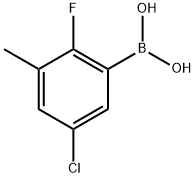5-CHLORO-2-FLUOROPHENYLBORONIC ACID
- CAS NO.:352535-83-2
- Empirical Formula: C6H5BClFO2
- Molecular Weight: 174.37
- MDL number: MFCD05664225
- EINECS: 675-613-5
- SAFETY DATA SHEET (SDS)
- Update Date: 2024-04-08 16:27:35

What is 5-CHLORO-2-FLUOROPHENYLBORONIC ACID?
The Uses of 5-CHLORO-2-FLUOROPHENYLBORONIC ACID
suzuki reaction
The Uses of 5-CHLORO-2-FLUOROPHENYLBORONIC ACID
Reactant involved in:
- Suzuki cross-coupling reactions
- Synthesis of biaryl amides with muscarinic acetylcholine receptor subtype M1 agonistic activity
- Synthesis of kinesin spindle protein inhibitors
- GABA α2/3 agonist preparation
Properties of 5-CHLORO-2-FLUOROPHENYLBORONIC ACID
| Melting point: | 122-127 °C (lit.) |
| Boiling point: | 310.8±52.0 °C(Predicted) |
| Density | 1.41±0.1 g/cm3(Predicted) |
| storage temp. | Keep in dark place,Sealed in dry,Room Temperature |
| form | powder to crystal |
| pka | 7.35±0.58(Predicted) |
| color | White to Almost white |
| CAS DataBase Reference | 352535-83-2(CAS DataBase Reference) |
Safety information for 5-CHLORO-2-FLUOROPHENYLBORONIC ACID
| Signal word | Warning |
| Pictogram(s) |
 Exclamation Mark Irritant GHS07 |
| GHS Hazard Statements |
H315:Skin corrosion/irritation H319:Serious eye damage/eye irritation H335:Specific target organ toxicity, single exposure;Respiratory tract irritation |
| Precautionary Statement Codes |
P261:Avoid breathing dust/fume/gas/mist/vapours/spray. P264:Wash hands thoroughly after handling. P264:Wash skin thouroughly after handling. P280:Wear protective gloves/protective clothing/eye protection/face protection. P304+P340:IF INHALED: Remove victim to fresh air and Keep at rest in a position comfortable for breathing. P305+P351+P338:IF IN EYES: Rinse cautiously with water for several minutes. Remove contact lenses, if present and easy to do. Continuerinsing. P405:Store locked up. |
Computed Descriptors for 5-CHLORO-2-FLUOROPHENYLBORONIC ACID
| InChIKey | GGTUVWGMCFXUAS-UHFFFAOYSA-N |
5-CHLORO-2-FLUOROPHENYLBORONIC ACID manufacturer
A.J Chemicals
New Delhi
Phone:91-9810153283
Whatsapp: 91-9810153283
product: 5-Chloro-2-fluorobenzeneboronic acid
New Products
Tert-butyl bis(2-chloroethyl)carbamate 4-Methylphenylacetic acid N-Boc-D-alaninol N-BOC-D/L-ALANINOL 3-Morpholino-1-(4-nitrophenyl)-5,6-dihydropyridin- 2(1H)-one Furan-2,5-Dicarboxylic Acid Tropic acid DIETHYL AMINOMALONATE HYDROCHLORIDE 1,1’-CARBONYLDIIMIDAZOLE R-2-BENZYLOXY PROPIONIC ACID 1,1’-CARBONYLDI (1,2-4 TRIAZOLE) N-METHYL INDAZOLE-3-CARBOXYLIC ACID (2-Hydroxyphenyl)acetonitrile 4-Bromopyrazole 5-BROMO-2CYANO PYRIDINE 5,6-Dimethoxyindanone 5-broMo-2-chloro-N-cyclopentylpyriMidin-4-aMine 2-(Cyanocyclohexyl)acetic acid 4-methoxy-3,5-dinitropyridine 2-aminopropyl benzoate hydrochloride 1-(4-(aminomethyl)benzyl)urea hydrochloride diethyl 2-(2-((tertbutoxycarbonyl)amino) ethyl)malonate tert-butyl 4- (ureidomethyl)benzylcarbamate Ethyl-2-chloro((4-methoxyphenyl)hydrazono)acetateRelated products of tetrahydrofuran








You may like
-
 5-Chloro-2-fluorophenylboronic Acid (contains varying amounts of Anhydride) CAS 352535-83-2View Details
5-Chloro-2-fluorophenylboronic Acid (contains varying amounts of Anhydride) CAS 352535-83-2View Details
352535-83-2 -
 5-Chloro-2-fluorophenylboronic acid CAS 352535-83-2View Details
5-Chloro-2-fluorophenylboronic acid CAS 352535-83-2View Details
352535-83-2 -
 1975-50-4 98%View Details
1975-50-4 98%View Details
1975-50-4 -
 2-HYDROXY BENZYL ALCOHOL 98%View Details
2-HYDROXY BENZYL ALCOHOL 98%View Details
90-01-7 -
 2-Chloro-1,3-Bis(Dimethylamino)Trimethinium Hexafluorophosphate 221615-75-4 98%View Details
2-Chloro-1,3-Bis(Dimethylamino)Trimethinium Hexafluorophosphate 221615-75-4 98%View Details
221615-75-4 -
 14714-50-2 (2-Hydroxyphenyl)acetonitrile 98+View Details
14714-50-2 (2-Hydroxyphenyl)acetonitrile 98+View Details
14714-50-2 -
 118753-70-1 98+View Details
118753-70-1 98+View Details
118753-70-1 -
 733039-20-8 5-broMo-2-chloro-N-cyclopentylpyriMidin-4-aMine 98+View Details
733039-20-8 5-broMo-2-chloro-N-cyclopentylpyriMidin-4-aMine 98+View Details
733039-20-8
Statement: All products displayed on this website are only used for non medical purposes such as industrial applications or scientific research, and cannot be used for clinical diagnosis or treatment of humans or animals. They are not medicinal or edible.